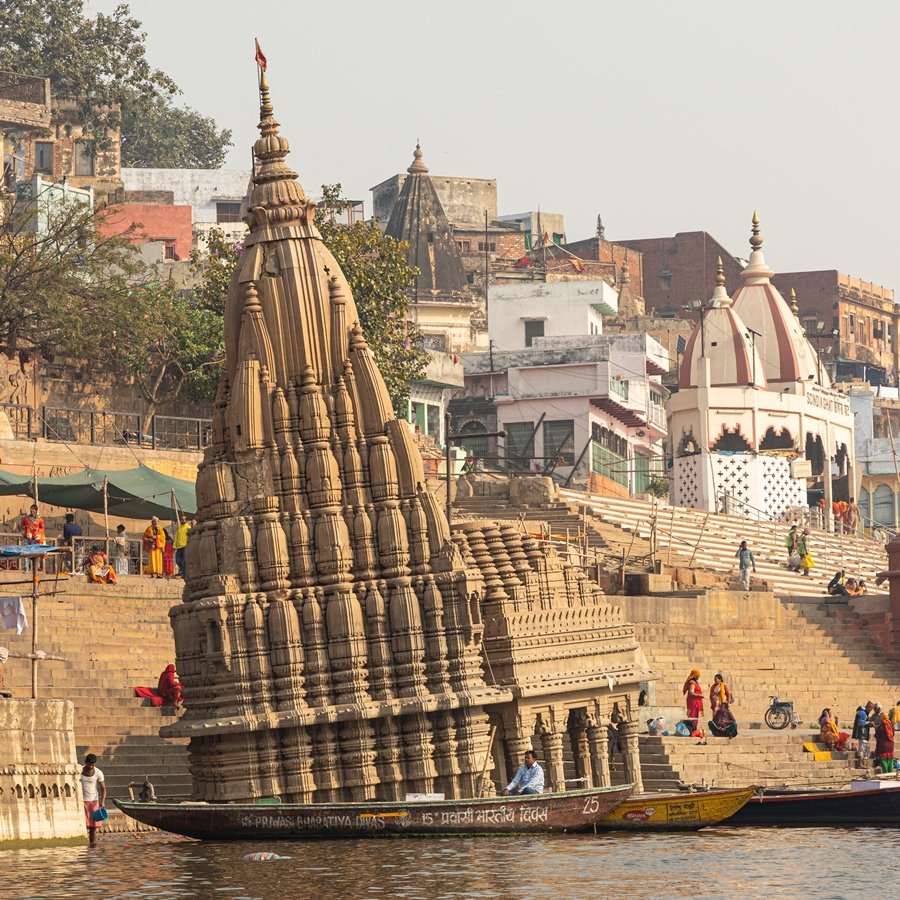India is home to many miracles and religious wonders. And on the riverbank of the holy Ganga in Varanasi, there is another wonder known as Ratneshwar Mahadev Temple. Ratneshwar Mahadev Temple is a great competitor of the famous leaning tower of Pisa. It is one of the two only leaning temples in the world. Luckily the other one is in India too. It is the leaning Temple Huma in Odisha.
You might have heard of the Leaning Tower of Pisa which is well-known in the world and has generated a lot of curiosity among the masses. Since decades, this historical monument has mesmerized viewers due to its structure, architecture, design and other components like it is leaning. But, have you come across the Leaning Temple of Banaras? Yes, the Ratneshwar Mahadev Temple in the spiritual town of Uttar Pradesh has garnered the attention of netizens after a user shared its photo on his Twitter handle, comparing this Temple with the Leaning Tower of Pisa.
The user claimed that this temple is taller than the Tower of Pisa and leans by 9 degrees. He further cited that the Tower of Pisa, which leans by just 4 degrees is popular, whereas this spectacular temple is not mentioned as a tourist destination.

Soon, many fact-checking websites came ahead and verified this claim. After verifying this viral message, this claim was stated to be true. Though there are many travel blogs and references to this temple for the last several years, now it has come to the limelight due to its comparison with the Tower of Pisa. As the user has rightly pointed that this temple is not much introduced as a tourist destination in India as well as the world, now many media outlets are focusing on the peculiarity of this temple.
Though a few sources initially stated that the height of this temple is 74 meters comparing it with the height of the Leaning Tower of Pisa is 57 m high. But after research, facts mention that the elevation of this Temple is 74 meters and not the height. The height is approximately 13-14 meters. It is located between Manikarnika Ghat and Scindhia Ghat of Benaras town. Most of the time, it remains underwater and is very close to the Ganges river. There are a lot of fascinating stories that explain why the inner sanctum of this temple remains submerged in water. Some references also highlight that the builders purposefully constructed the temple in that way and it was a collective choice.
Also Read: Top Attractions of Puri, Orissa
And surprisingly, the tilte of Ratneshwar Mahadev Temple is at 9 degrees, which means it is 5 degrees more inclined than the wonder of Pisa. The temple is at the bank of Manikarnika Ghat in Varanasi. The famous Ratneshwar Mahadev Temple is also known as Kashi Karvat (Kashi is the ancient name for Varanasi and karat means leaning in Hindi).
One of the beliefs asserts that the temple ghat collapsed and leaned backwards after not being able to bear its weight. However, before the 1860s, the temple was supposed to have stood straight and no concept was ‘leaning’ was found. As per some pieces of evidence and paintings of the ghats from the early to mid-19th century, this architectural marvel is mostly visible in Ratneshwar Mahadev and is distinctly unique from other temples.
If we talk about the architecture of this temple, it is gracefully constructed in a classic style with a nagara shikhara and phamsana mandapa. In terms of architecture, Mandapa is a pillared hall or pavilion for public rituals. With a very rare combination, the temple is built at a low level to the holy river Ganga. Interestingly, the water level can reach the shikhara part (apex) of the temple. As the builder was aware that its garbhagriha would be underwater for most of the time, it is constructed at a very low spot. Though this temple is underwater, it is preserved and valued even now.
However, during monsoons, no rituals are performed in this temple. Voice of prayers and worships are not heard in the rainy season. One cannot see and hear bells ringing. Some people also believe that it is a cursed temple and offering prayers can cause something bad in their house.

This temple, constructed in the mid-19th century is also addressed by the name ‘Kashi Karvat’. In Hindi, karvat means leaning. It is still unclear that who built the temple. As per one of the fables, it was erected over 500 years ago by a servant of Raja Man Singh, for his mother Ratnabai. Once the temple was ready, the servant was proud of this achievement and said that he returned and paid the debt to his mother. The fable further tells that every son is obliged to fulfill his responsibilities and the debt to one’s mother can never be repaid. Hence, the temple started to lean.
Also Read: What to see in Ganpatipule
Another myth advocates that a female servant of Ahilyabai Holkar erected the temple. As this servant whose name was Ratnabai, named the temple after herself, Ahilyabai didn’t like it and cursed the temple to lean. Other references also reveal that it was constructed by either the Queen of Gwalior or the Amethi’s royal family.
Though it is one of the most photographed temples in the holy city of Varanasi, it is still not considered as a tourist spot. This temple which is rich and diverse in its own approach should be well conserved without disturbing its uniqueness. Hence, this leaning tower of Banaras with its exclusive features will continue to gather the appreciation as well as astonishment by the viewers.
Travel and explore the most iconic places of the world with our Travel Articles.




